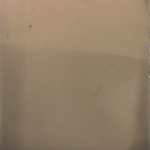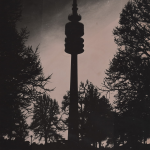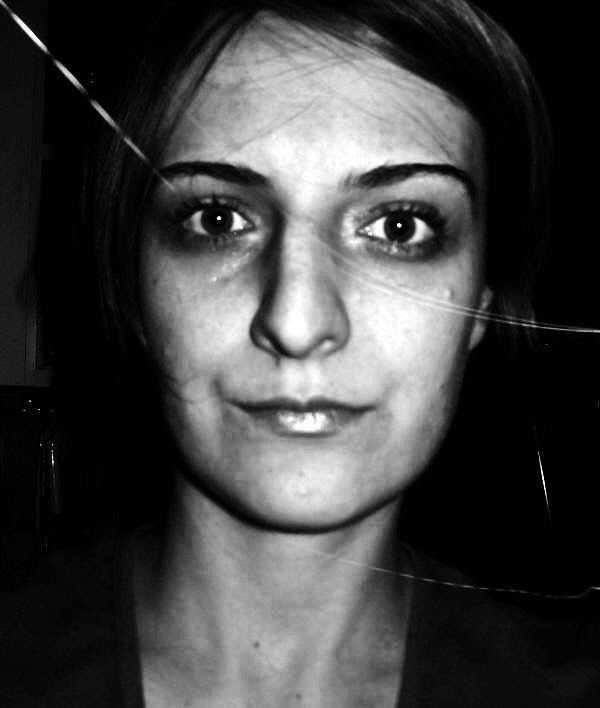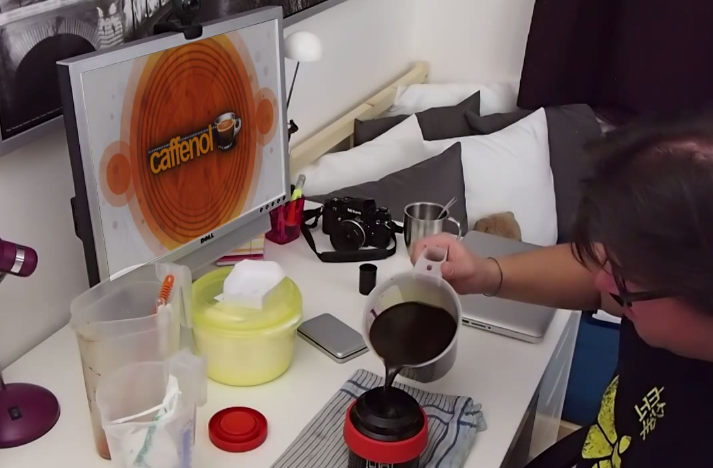Wineol – Red Wine developer
Niklas Rühl posted a picture in our Facebook Group of a negative developed in Wineol, an alternate devolper that is made out of Red Wine, Washing Soda and Vitamin C. The whole process and some really nice pictures can be seen on his website. The site is in German,so here is a google translation. I knew already that it is possible to mix up other developers which are based on Washing Soda and Vitamin C, but never really had the interest to try it. But as I did some enlargements recently, why don’t try it as a paper developer. That said I took the cheapest Red Wine I have and mixed up some developer. As I always use plenty of Vitamin C in my recipes, I used the following formula:
- 400ml Red Wine (just any Red Wine will do)
- 40g of Washing Soda
- 10g of Vitamin C
The results are interesting. And there is plenty of room for experimenting and improvement. Here you can see a side by side print of a negative-scan and the Wineol developed printed paper:  As you can see, it gives a nice brownish, violet toning to the paper, my print is way overexposed, it almost looks like a duotone picture. When I have a bit more time, I will go back and try to properly expose this and see how it looks like then. I have recorded the whole process on video, so if you ever wondered, how my darkroom looks like, or in which direction I stir my developer, here you have 10 minutes with me in the maybe smallest Full-Equiped Darkroom you have ever seen.
As you can see, it gives a nice brownish, violet toning to the paper, my print is way overexposed, it almost looks like a duotone picture. When I have a bit more time, I will go back and try to properly expose this and see how it looks like then. I have recorded the whole process on video, so if you ever wondered, how my darkroom looks like, or in which direction I stir my developer, here you have 10 minutes with me in the maybe smallest Full-Equiped Darkroom you have ever seen.
If you happen to be on Facebook, make sure you join the Caffenol Facebook group, it’s a nice community with people from all over the World. And if you have other suggestions, advices, or experiments you want to share on caffenol.org, just give me a shout through the contact form or leave a comment here.








44 Comments
Tobias · June 20, 2012 at 1:33 pm
Really nice, you tried the paper developing with wineol and it looks encouraging. As i wrote on my blog and on http://kwerfeldein.de/2012/06/08/entwickeln-mit-wineol-optimale-bedingungen-viel-rotwein/ niklas used basically i did a a bit of research an tried diffrent kind of wines and films. As you can see there´s much potential to optimize recipes and diffrent kinds of developing.
It´s a challenge and it´s really funny, isn´t it?
dirk · June 20, 2012 at 1:39 pm
Tobias,
yes it’s a lot of fun experimenting with this stuff. I really want to compare it with prints developed in caffenol and in Rollei RPR.
Niklas · June 20, 2012 at 3:33 pm
Hi there! Very amazing stuf… But the google-translation of my article is … let’s say – strange. If there are some more worldwide readers, I will try to translate it myself.
Many regards
Niklas
Mathias · June 20, 2012 at 5:21 pm
Great stuff! Love your darkroom 🙂 I’ll have to try this sometimes. And nice special effects when you show the last print near the end 😉
Eero · June 28, 2012 at 1:58 pm
Have you tried developing film or paper with Vita Cola? Vita Cola has both caffeine and vitamin C, it might be worth a try.
dirk · June 28, 2012 at 2:12 pm
I will try to get some and try it!
Eero · June 28, 2012 at 7:36 pm
I would try it myself because it is my favourite cola, but it is very very expensive in Finland.
dirk · June 29, 2012 at 9:59 am
How much is ‘Very expensive?’
Eero · July 2, 2012 at 5:25 pm
1L bottle for 3,5€
Buddy · July 4, 2012 at 6:09 pm
Hey,
where dit you get this “calculator scale” ?
lg
Buddy
dirk · July 7, 2012 at 2:05 pm
Hi Buddy,
I got it from here:
http://www.porters.com/projection-print-calculator-scale-4×5.html
ximena · July 6, 2012 at 8:58 pm
¿por qué se demora tanto en revelar la imagen con el vino?
dirk · July 7, 2012 at 2:06 pm
Because there is not so much caffeic acid in Red wine, so development takes longer. (Question was: why does it take so long to reveal the image with the wine?)
nancy · July 15, 2012 at 5:35 pm
what is washing soda, not a familiar term
A.j. Ross · March 13, 2017 at 2:19 pm
Washing soda is Sodium carbonate. It can be found with the stain lifters and borax in most grocery stores where the clothes washing detergents and soaps are. It should say “washing soda” on the label. Check the back or side label to make sure that it is Sodium carbonate (should be under “Ingredients” or “active ingredients”).
If you can find one that specifies “Anhydrous” (meaning only 1 hydrogen molecule) it is better. Though I’ve never had an issue with ones that did not specify “anhydrous” and usually to get Sodium Carbonate that DOES specify anhydrous it’s usually the laboratory grade compounds that are really expensive. Here a 5lb box is about $3 which should be about 2.6 euros.
.
A.j. Ross · March 13, 2017 at 2:21 pm
Washing soda is different from baking soda (Sodium Bi-Carbonate/bicarbonate) in that it only has one molecule of carbon attached to the sodium molecule. Baking soda will not work and will trash your mixture and films or papers. Some say you CAN heat baking soda in the oven on warm for 30 minutes to break off a carbon and hydrogen molecule and make washing soda if you need some in a pinch; say if you were to get set up and find that your washing soda had absorbed moisute from the air and was all clumpy. I have encountered this and have tried it. I had 1 success and 2 failures where there was almost no images on the negatives because they were so faint. I would not recommend trying this.
I hope this helps.
If you have any further questions feel free to ask away, I’m sure someone will be quite pleased to assist
theblindpoet · November 18, 2012 at 9:53 pm
really enjoyed watching this, and seeing the darkroom. I will try this for sure…….and drink the wine left over
Tom Overton · February 20, 2013 at 12:22 am
Thank you, Dirk. I really enjoyed your video. I tried this this afternoon and got several nice prints. As with Caffenol I tend to use about 5-10% of depleted paper developer with slower papers. This seems to get things moving and overcomes the threshold of development.
Thanks again. I appreciate the time you took to make this video.
Johnny · May 18, 2013 at 4:43 pm
Hey there,
it is about the “calculator print scale” again. Do you think it would be possible to scann it so that we could print it out on transparent film at home.
Many regards
Niklas
dirk · May 31, 2013 at 6:11 pm
Niklas,
the print scale can be bought here: http://www.macodirect.de/delta-print-calculator-p-2540.html?osCsid=a2897f6362d33746bc2e627e3b52803e
Joachim · June 26, 2014 at 10:16 pm
Dear all,
I am following your activities with great interest.
Still, I got some questions about substituting (instant) coffee as a source of caffeic acid.
Clearly, red wine seems to be doing the trick, but, it also tints the media. Has anyone experimented with white wine so far? It seems that white wine contains some caffeic acid too:
http://www.phenol-explorer.eu/contents/graph?compound_id=457&experimental_method_group_id=2&food_id=137&unit_type=weight
I figure that a developer using white wine, maybe with some additional ascorbic acid, could have an advantage over red wine developer, in terms of not introducing pigments.
Greetz, Joachim
dirk · June 27, 2014 at 9:05 am
For sure I will try this out.
Joachim · June 27, 2014 at 9:42 am
Hi Dirk,
ich nochmal…
Did some additional research on caffeic acid, and it seems that white grapes are actually a major source for it:
http://www.skinandallergynews.com/views/cosmeceutical-critique-by-leslie-s-baumann/blog/caffeic-acid/5be431eb4418c47d008ed4d6a9534421.html
As soon as my ascorbic acid order to arrived, and will give it a try with cheap Chardonnay.
Beste Grüße,
Joachim
Kelly · October 8, 2015 at 1:44 am
Did you do this with fiber paper or RC paper?
BestTrinidad · May 2, 2018 at 12:51 am
I have noticed you don’t monetize your site, don’t waste
your traffic, you can earn extra bucks every month because you’ve got high quality
content. If you want to know how to make extra bucks, search for: Ercannou’s essential adsense alternative
Revelando fotografías con vino tinto « Francisco Unica · June 27, 2012 at 3:53 pm
[…] Caffenol, nos cuentan siempre formas originales de seguir revelando película. Más conocido y […]
How To Develop Film With Red Wine [Video] | IOS 6 Release Date · June 28, 2012 at 6:41 pm
[…] a mix of coffee and vitamin C instead of the usual chemicals found in a darkroom. But over at the Caffenol blog, they’ve started experimenting with a red wine-based developing solution as […]
How To Develop Film With Red Wine [Video] « VidenOmkring · June 28, 2012 at 6:42 pm
[…] a mix of coffee and vitamin C instead of the usual chemicals found in a darkroom. But over at the Caffenol blog, they’ve started experimenting with a red wine-based developing solution as well. […]
Tech-Critics: How To Develop Film With Red Wine [Video] · June 28, 2012 at 7:01 pm
[…] a mix of coffee and vitamin C instead of the usual chemicals found in a darkroom. But over at the Caffenol blog, they’ve started experimenting with a red wine-based developing solution as well. […]
How To Develop Film With Red Wine [Video] | Sarah Michelle Gellar · June 28, 2012 at 11:18 pm
[…] a mix of coffee and vitamin C instead of the usual chemicals found in a darkroom. But over at the Caffenol blog, they’ve started experimenting with a red wine-based developing solution as well. […]
Today’s Links | Test site · June 29, 2012 at 12:36 am
[…] a mix of coffee and vitamin C instead of the usual chemicals found in a darkroom. But over at the Caffenol blog, they’ve started experimenting with a red wine-based developing solution as well. […]
» How To Develop Film With Red Wine [Video] Gamez Menu · June 29, 2012 at 7:02 am
[…] a mix of coffee and vitamin C instead of the usual chemicals found in a darkroom. But over at the Caffenol blog, they’ve started experimenting with a red wine-based developing solution as well. […]
How To Develop Film With Red Wine | Gizmodo Australia · June 29, 2012 at 7:15 am
[…] [Caffenol via PetaPixel] […]
Wineol: Alternative Fotoentwicklung mit Rotwein - GIZMODO DE - Das Gadget-Weblog · June 29, 2012 at 10:05 am
[…] genaue Anleitung, wie ihr die Rotwein-Entwicklung am besten angehen könnt, hat der Blog caffenol in einem Video […]
How To Develop Film With Red Wine [Video] « Robot Insurance · June 29, 2012 at 12:00 pm
[…] a mix of coffee and vitamin C instead of the usual chemicals found in a darkroom. But over at the Caffenol blog, they’ve started experimenting with a red wine-based developing solution as well. […]
How To Develop Film With Red Wine [Video] · June 29, 2012 at 1:27 pm
[…] a mix of coffee and vitamin C instead of the usual chemicals found in a darkroom. But over at the Caffenol blog, they’ve started experimenting with a red wine-based developing solution as well. […]
Revelando película fotográfica con vino tinto. | Oscar Vífer · June 29, 2012 at 10:59 pm
[…] Mas info | CAFFENOL […]
Revelando fotografías con vino tinto. | Oscar Vífer · June 29, 2012 at 11:04 pm
[…] Mas info | CAFFENOL […]
No sólo los humanos consumimos vino | El Blog del Sumiller · September 5, 2012 at 8:31 am
[…] Pero sin duda alguna, uno de los usos más insólitos usos del vino lo encontramos en el mundo de la fotografía. Se trata de utilizar el producto en elproceso de revelado de las fotografías para darles una apariencia de antigüedad. Los aficionados a la fotografía están acostumbrados a experimentar con el uso de la vitamina C e incluso con el café, pero ahora se empieza a utilizar también el vino tinto en lo que se conoce como técnica Wineol. […]
Curcuma + Caffenol = Curcuffenol • Sîn Taedi · September 12, 2016 at 1:21 pm
[…] Je voulais savoir quelle partie du procédé de développement au caffénol permettait d’obtenir une image. J’ai découvert qu’un des élément important était l’acide caféique. C’est un composant présent dans toutes les plantes, mais en proportions plus importantes dans certains fruits (baies, pêches, pommes…) et, entre autres, dans le vin, le café, le curcuma et la cannelle. Cela explique pourquoi nous pouvons aussi développer des photos grâce au procédé appelé “wineol“. […]
Curcuma + Caffenol = Curcuffenol – Sîn Taedi · September 2, 2017 at 6:39 am
[…] Je voulais savoir quelle partie du procédé de développement au caffénol permettait d’obtenir une image. J’ai découvert qu’un des élément important était l’acide caféique. C’est un composant présent dans toutes les plantes, mais en proportions plus importantes dans certains fruits (baies, pêches, pommes…) et, entre autres, dans le vin, le café, le curcuma et la cannelle. Cela explique pourquoi nous pouvons aussi développer des photos grâce au procédé appelé « wineol« . […]
Curcuma + Caffenol = Curcuffenol – Sîn Taedi · September 2, 2017 at 9:00 am
[…] Je voulais savoir quelle partie du procédé de développement au caffénol permettait d’obtenir une image. J’ai découvert qu’un des élément important était l’acide caféique. C’est un composant présent dans toutes les plantes, mais en proportions plus importantes dans certains fruits (baies, pêches, pommes…) et, entre autres, dans le vin, le café, le curcuma et la cannelle. Cela explique pourquoi nous pouvons aussi développer des photos grâce au procédé appelé “wineol“. […]
3 Ways To Develop Film At Home In A More Evironmentally Friendly Way – The Photography Professor · April 9, 2021 at 5:06 am
[…] https://www.caffenol.org/2012/06/20/wineol-red-wine-developer/ […]
Procesamiento de fotos de bricolaje: cómo desarrollar una película en casa para usar café barato, vino tinto o Tylenol · October 8, 2021 at 10:55 pm
[…] la guía de vinos tintos en Caffenol.org para ver cómo se […]